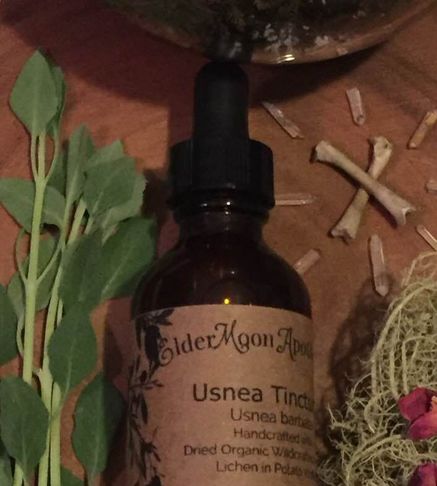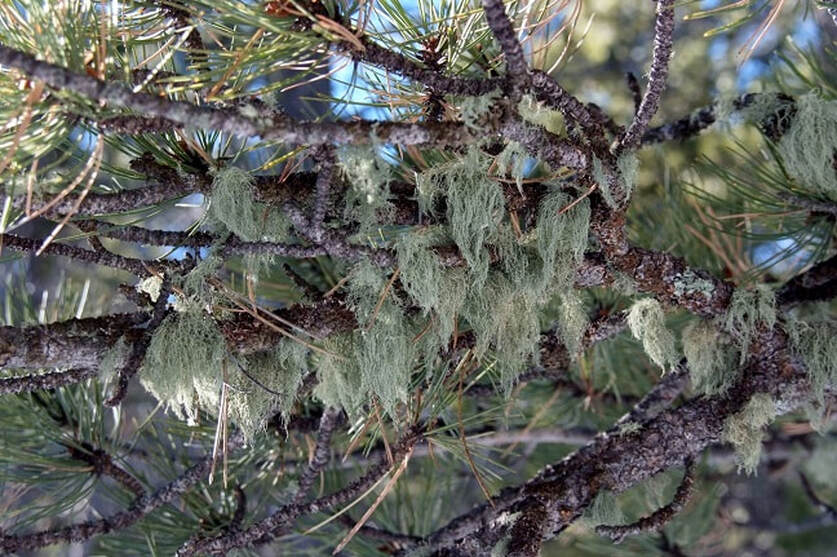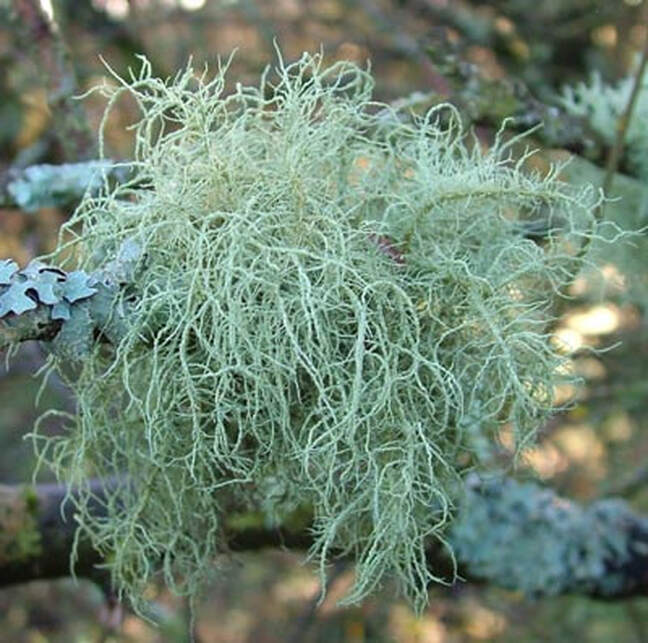|
COMMON NAME: Usnea Other Names: usnea lichen, old man's beard BOTANICAL NAME: Usnea barbata, Usnea longissima, Usnea hirta. Usnea plicata, Usnea fillipendula, (there are 600 known species but these are the most commonly studied and utilized species for medicine). Plant Family: Usneaceae CONSTITUENTS: Usnic acid, essential fatty acids, mucilage, sterols, and many more not being listed here at this time. PARTS USED: dried thallus, also called lichen strands. PREPARATIONS: Tincture, liniment, compress/fomentation, poultice, cough syrups, cold lozenges, decoctions, wound washes, wound packing & powder, douches, sitz baths. Taken internally and applied externally. Tincture can be applied as liniment to skin full strength or added to mister bottles with water and essential oils for skin fungus and infections. To bathe sinuses add 2-3 drops of tincture to netty pot washes. MEDICINAL ACTIONS: Analgesic, Antimicrobial, (Antifungal, Antibacterial, Antiviral, Antiparasitic, Antiprotozoan), Antiseptic, Antiproliferative (cancer), Immunostimmulant, Anti-inflammatory, Antineoplastic (cancer), Antioxidant PRECAUTIONS: Not for use during pregnancy is often reported by many. No other known precautions exist. I will share that with flu and pregnant, I did enlist the support of Usnea with great results. My rule with plants where we just don't know the effects during pregnancy and yet there seems to be good reason for it to be fine is to take 1/4 the dose to start. The pregnant body is very sensitive and requires very small doses and can work with this well because of the heightened state we are in when pregnant. You get to decide for you and your baby. This is not based in any research nor is it a suggestion. I only share what I've experienced. THE MEDICINE: Walking through the forest is where one will encounter Usnea. Did you know know that the inconspicuous gray-green fuzzy plant covering many of the trees is one of the gentlest yet strongest immune tonics and antimicrobials in the herb world? Usnea is a lichen; a combination of an algae and a fungi growing together symbiotically on the surface of the tree. Also known as Old Man's beard, it grows in little hair-like tufts, with the green algae covering the white string like fungi. The best way to identify Usnea is to pull a string apart and look for this white thread. No white thread means it's not Usnea. I do recommend showing a sample to a knowledgeable person to confirm you've got the right plant. Some people say that the Usnea lichen likes to grow in old growth forests. It must be true but I've seen it on younger trees too. Stephen Buhner has suggested that Usnea serves as the lungs of the forests they grow within, and in some way supports the overall health of the ecosystem. I believe this to be true. It carries the energy of a wise elder, maybe a grandfather for me. This plant grows profusely in wet climates, like the Pacific Northwest, where tufts can be up to a foot long. The species that grow here in the northeast tend to be smaller, which can make gathering it a tedious task. I find gathering after a big wind storm good because the wind will blow down the Usnea from the higher branches. I grew up in orchards and the old abandoned apple trees had lots of Usnea growing on them. Usnea is an immune system tonic that can be used in acute situations as well as for long term immune enhancement and general prevention. It has no side effects or contraindications, and is safe for children and animals. It can be taken along with or instead of Echinacea. Usnea is more specific for strep and staph infections than Echinacea, and the antibiotic properties are most specific to the respiratory and urinary systems. We take to help heal respiratory and sinus infections, bronchitis, pneumonia, strep throat, colds, flus, as well as urinary tract, kidney, and bladder infections. Usnea is also beneficial for women with yeast infections, trichonomosas, bacterial vaginosis, and chlamydia. It can be helpful as part of the plant-based remedies taken for people with chronic fatigue, HIV, herpes, and other chronic conditions related to depressed immunity, especially when taken in a pulsed fashion for acute flare-ups within the chronic condition expression. Usnea can also be used externally for outbreaks of staph, cellulitis, or infected wounds. I generally use the powdered herb, strong decoctions applied with a cloth, or the diluted tincture for open skin and straight tincture for closed skin. The moistened herb also makes an excellent bandage to be used directly on the wound or affected area. Should you have the great fortune of being near this one fresh when an injury happens, packing the wound with fresh plants after bleeding has been addressed is perfect for keeping the wound tended until you can get to a better situation for cleaning the wound. This tough yet delicate looking little plant (not plant, lichen) doesn't make much of a tea due to having so little water soluble properties, so I recommend using it as a tincture. The heat required to make many medicines will however take the place of the alcohol so you may stay water-based in your preparation if alcohol is a concern. Increase your dose by 1/4-1/2. I've made a throat spray by diluting the tincture with water, Essential Oil of Eucalyptus, and Honey. It was a spontaneous creation that works great and seems to have the ability to kill microbes on contact. I also, as stated above, place 2 drops of tincture into a full netty pot for sinus irrigation. I do this when I know I've been around the flu or have started active symptoms. I also take it internally 30 drops 3-5x/day and add to cough syrups too. I've found it to be quite effective with serious cases of bronchitis and pneumonia. Dosing will be increases from 2-3x/day to every 4 hours 30-60 drops to 1/2 teaspoon of tincture with convalescence and bone or medicinal mushroom broth based soups for a few days. Let’s be wise my friends. If someone can no longer walk well or maintain their oxygen levels so they look pale and grey (awful), seek medical attention. These are advanced distress signs of a very weak system so unless you are comfortable with what this looks like and what to do, seek help and learn. Watch closely so you can learn well from the experience. And yes, one can treat with plant medicines and modern medicines together. Seek guidance on how if you are inexperienced. Herbalists were ordered with threats to be silent by the FDA during the Anthrax scare. This was the first plant turned to for protection from inhaled life threatening situations; second to quarantine. Hypothetically speaking, dilute the tincture in a spray bottle with Eucalyptus essential oil and mist in front of the face for inhaling. I add 60 drops of Usnea tincture to 2oz. of water with 20 drops of the Eucalyptus essential oil. It could be called, hypothetically speaking, an "air purifying spray". Also use the netty pot with 2-3 drops of tincture only (more than this burns the sinuses). For Weight Loss? NO. It was reported to help with this by isolating Usnic acid and concentrating it and people were hurt most likely due to toxicity from receiving the plant in compound isolated form. Work with the full spectrum of whole plant preparations for safety reasons. The FDA was considering banning the plant due to this but it has fallen away a bit thankfully. Do educate that this is not a way to work with Usnea. TINCTURE MAKING CONSIDERATIONSUsnea has water soluble and non-water soluble compounds and so there are suggestions by herbalists to provide a two part preparation for making the tincture in order to extract the full spectrum of the medicine offered. For alcohol sensitive people, a syrup or glycerite made with heat will provide a good option but I would suggest larger dosing (double the dose). The polysaccharides are found in the fungi portion of Usnea (white inner core) and are part of the water soluble medicine. The alkaloids and acids found in the outer green algae part of Usnea are extractable in 90-95% alcohol, this being the non-water soluble parts. There are other compounds identified and unidentified but by making your tincture in this two part process you will be getting the full spectrum of what Usnea has to offer for healing. Making Usnea barbata Tincture – A Two Part Extraction Process Usnea Tincture at 1:5 dried 45% alcohol – Adult Suggested Dose: 1-2 dropperfuls 1-4x/day depending on the health condition and presenting symptoms. PART 1: You’ll need 3-4 oz dried usnea, Everclear 90-95% Alcohol + 1 quart jar
CONGRATS! You now have a dual-extracted, highest potency Usnea tincture made by you! I also do this cook process for other healing herbs such as Astragalus root, all medicinal mushrooms, Ginger root, and a few other tinctures to honor their water soluble compounds as well as their converted-by-heat compounds they have. Cannabis is proving to fit into this category of healing plants/lichens/fungi as well with it's need for decarboxylation to potentize certain compounds. Some herbalists now do this two-part extraction with all dried roots and barks to be tinctured. I’m grateful to Stephen Buhner, Ryan Drum, and Christopher Hobbs for pioneering the simple techniques of a two part process to make a more potent tincture.
Usnea is also an indicator plant to the health of an area as far as pollutants are concerned. Christopher Hobbs has shared many a time on how Usnea will recede from highly contaminated places because it absorbs such toxins easily due to the nature of it's growth pattern. We would not want to make medicine from this and this wise medicine lichen will not allow it either. This is surely another way the wise protection held in the medicine reaches through. And so to find it is a great reason for ceremony and rejoicing for me. Processing Usnea for External Use Usnea has very tough cell walls! Therefore, you need to break up its surface area— by grinding, mashing, or chopping to make its medicine more bioavailable. For an herbal powder which can be used to clean and treat wounds, simply air dry the Usnea (it dried so fast and often in a few days just sitting around in basket), and then grind it into a fine consistency using a mortar and pestle or an electric grinder. This powder can be sprinkled directly into wounds, or you can simmer for 30 minutes, and add other antimicrobial plants (love rosemary, plantain, yarrow, calendula to name a few), steep, strain, and wash wounds or apply compresses with the warm to cool tea. Harvesting Usnea Usnea takes a long time to grow. Therefore, I only harvest it from dead fallen branches rather than from living trees. Make sure you’re harvesting the right lichen! One distinguishing feature of Usnea is the presence of a thin, thread-like, white central “cord” that is revealed when you pull apart the outer sheath of the thicker main strands of the lichen. These cords have an elastic consistency to them, so when you pull them apart, they should be rather springy/snappy. When harvesting Usnea, look for the vibrant, brighter colored specimens as opposed to those that have been hanging out on the ground for a long time and look semi-decayed and brownish. I like to harvest Usnea using a knife or clippers, that way I can easily separate the lichen from the branches that they’re growing on and leave any bark or other debris behind. This also leaves the “roots” of usnea embedded in the tree where it can continue with its own life process. Make sure you harvest away from roadsides or developed areas as Usnea can absorb toxins and heavy metals from the environment. When in Ecuador high in the Andes Mountains hiking in the forest, tufts of Usnea floated down into my hands one morning. It was one of those moments that stops you for it's undeniable how plants can come to us in seen and unseen ways, calling our attention deep in our heart and soul to connect. To make and honor that bond deeper than before. Thank you so much for wandering through here with me. Much Love, Jen
1 Comment
Juanita
2/20/2021 03:41:52 pm
Hi, I want to make a oil infusion with Usnea. I’m not sure if heat is needed. Could you clarify?
Reply
Your comment will be posted after it is approved.
Leave a Reply. |
Details
Jennifer Costa, Herbalist-RN, Teacher, Botanist BS, EM-CST, and Founder of ElderMoon School of Herbs & Earth MedicineCategories
All
Archives
January 2023
|




 RSS Feed
RSS Feed